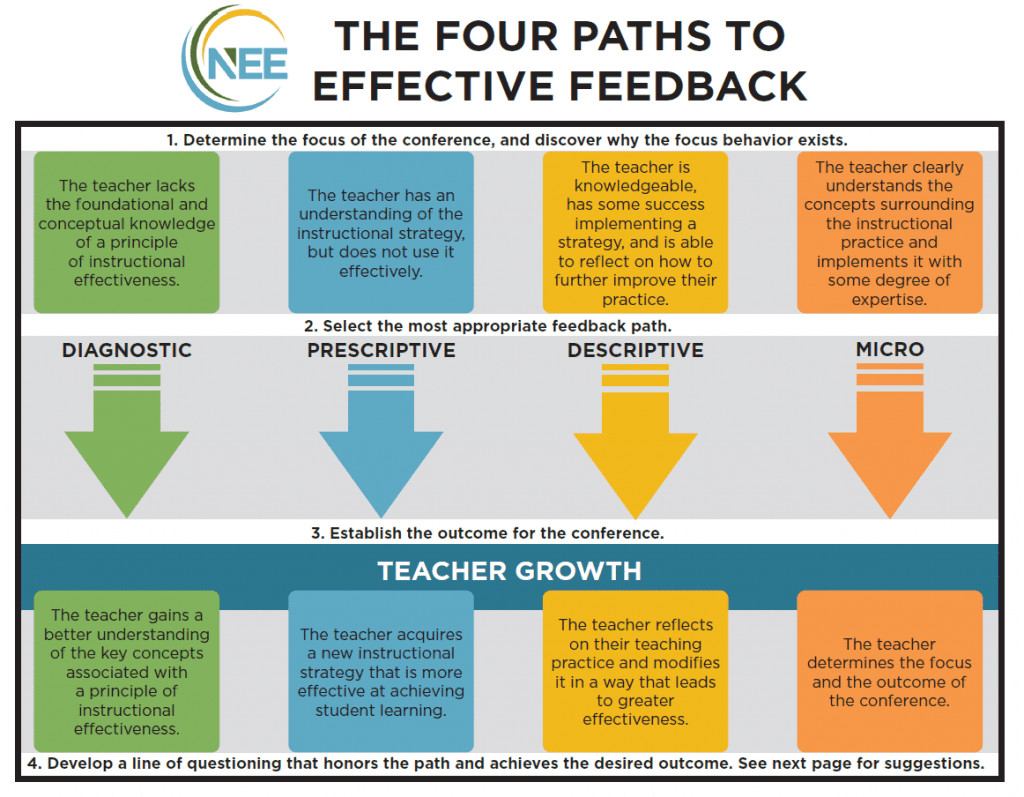Prescriptive Feedback Helps Teachers Develop Effective Use of an Instructional Strategy
As a former assistant superintendent leading PreK-12 academic programs, I often discussed with the other administrators in my district that there was no magic potion that was going to suddenly cause students to grow academically. We weren’t going to implement a new strategy that was going to lead to high academic achievement overnight.
It is important to seek strategies that will improve student academic performance, but sometimes we get caught up in implementing new strategies and we forget the impact administrators can have on student achievement through a teacher evaluation process based on research-based practices. Research shows that teacher reflection on instructional practice, as facilitated through classroom observations and feedback, can be a valuable method for improving instructional effectiveness and student achievement. The Network for Educator Effectiveness teacher evaluation model places significant importance on feedback to support teacher growth.
To help administrators hone their feedback skills, NEE developed the Four Paths to Effective Feedback based on the needs of the individual teacher. The four feedback paths are:
- Diagnostic
- Prescriptive
- Descriptive
- Micro feedback
Perhaps one of the biggest opportunities for teacher growth exists with teachers who fit the prescriptive feedback path. Teachers for whom this path is designed have demonstrated an understanding of the importance of addressing an indicator in a lesson they’ve taught but failed to effectively implement a strategy or strategies in their classroom lesson.
Not all failures are created equal, though. A teacher who has experienced failure yet understands the importance of the strategy they tried to implement can, with help from their administrator, build on the lessons learned from the experience. The intended outcome of the prescriptive feedback conference is to help teachers acquire a new instructional strategy that is more effective at achieving student learning.
The following steps can help administrators hold a prescriptive feedback conference that redirects a teacher’s failure into a stepping stone for improvement.
Start with the Positive
In a prescriptive feedback conference, administrators should ask questions that allow the teacher to demonstrate their understanding of the strategy they attempted to implement. These questions should reinforce the importance of the indicator to the success of a lesson and recognize the teacher for attempting to address the indicator through their use of their chosen strategy even if it wasn’t successful.
Identify What Went Wrong
It’s important to establish that the teacher’s attempt was not successful. The administrator should ask questions to identify how and why the teacher was not successful in implementing the strategy to address the indicator. Often the teacher will be able to identify some of the reasons for their lack of success, but maybe not all of them. This is an opportunity for the administrator to review the data from the observation and work with the teacher to identify what they may not have noticed.
Establish Next Steps
There are times that we all need help in working through a problem. A teacher who has not been successful in their lesson implementation can be easily discouraged. This is the time for an administrator to step in and help by supplying a strategy that will better address the indicator. Once the strategy is chosen, the administrator needs to determine what is needed for implementation. This may include observing another teacher using the strategy; working with the administrator, an instructional coach, or another teacher to plan for implementing the strategy; team-teaching with another educator using the strategy; or other activities to lead the teacher to be comfortable with using the strategy.
Continue to Support
Once an administrator has invested the time in helping the teacher grow in the use of a strategy, it’s important to continue to monitor the teacher’s use of the strategy, to offer feedback for continuous improvement, and to maintain expectations for effective use of the strategy.
Using the appropriate feedback path with each of the teachers you evaluate may not be a magic potion leading to overnight academic success, but it is the type of work that leads to slow and steady teacher growth that provides a better learning environment for your students.
Chuck Mayes is a NEE trainer and field support representative. He retired in 2020 after 30 years in K-12 public education where he served as a teacher, elementary principal, middle school principal, and for eight years as the Sikeston Chief Academic Officer/Assistant Superintendent working with curriculum, assessment, gifted education, and virtual learning.
The Network for Educator Effectiveness (NEE) is a simple yet powerful comprehensive system for educator evaluation that helps educators grow, students learn, and schools improve. Developed by preK-12 practitioners and experts at the University of Missouri, NEE brings together classroom observation, student feedback, teacher curriculum planning, and professional development as measures of effectiveness in a secure online portal designed to promote educator growth and development.




